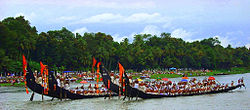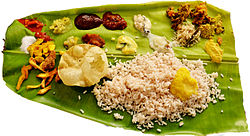

This article relies largely or entirely on a single source. Relevant discussion may be found on the talk page. Please help improve this articlebyintroducing citations to additional sources.
Find sources: "Aranmula Boat Race" – news · newspapers · books · scholar · JSTOR (February 2009) |
| Aranmula Boat Race
Aranmula Vallam Kali
| |
|---|---|

Aranmula Uthrattathi Boat Race
| |
| Status | Active |
| Genre | Festival |
| Date(s) | Utthrattathi Nakshatra in the Malayalam Calendar month of Chingam (Aug/Sep accordingly) |
| Frequency | Annually |
| Venue | Pampa River, Aranmula Parthasarathy Temple |
| Location(s) | Aranmula Pathanamthitta District, Kerala |
| Coordinates | 9°19′40″N 76°41′18″E / 9.32778°N 76.68833°E / 9.32778; 76.68833 |
| Country | |
| Inaugurated | 1972 |
| Previous event | 15 Sep 2019 |
| Next event | 02 September 2023 |
| Organised by | Palliyoda Seva Sangham |
| Website | aranmulavallamkali |
The Aranmula Boat festival is the oldest river boat festival in Kerala, the southwestern State of India is held during Onam (August–September). It takes place at Aranmula, near Sri Parthasarady Temple dedicated to Lord Krishna and Arjuna in Pathanamthitta district of Kerala State. The snake boats move in pairs to the rhythm of full-throated singing and shouting watched by an exciting crowd.[1] In 1972, snake boat races were also added to the program of the festival, hence the name Aranmula Boat Race. Thousands of people gather on the banks of the river Pampa to watch the snake boat races. In 2019 Fifty Two snake boatsorPalliyodams had participated in the festival. The oarsmen sing traditional boat songs Vanchippattu and wear white mundu
This article may be confusing or unclear to readers. Please help clarify the article. There might be a discussion about this on the talk page. (February 2024) (Learn how and when to remove this message)
|
[when defined as?] and turbans. The golden lace at the head of the boat, the flag and the ornamental umbrella at the center make it a show of pageantry too.
Aranmula is about 128 km from Trivandrum, capital city of Kerala. It is situated on the banks of the river Pampa in Pathanamthitta district of Kerala. The famous temple at Aranmula is dedicated to Sree Parthasarathy of Lord Krishna as the divine charioteer of Arjuna. A rough estimate puts the age of this temple to 1700 years.[citation needed]

Palliyodams are Aranmula’s unique snake boats (Chundan Vallam) which devotees hold in reverence, considering it as the divine vessel of the presiding deity in Sree Parthasarathy temple. These Palliyodams belong to different Karas (rustic parts) on the banks of river Pampa. The first Palliyodam was built by Nedumprayar kara situated near Aranmula.Each Palliyodam will usually have 4 helmsmen, rowers and singers. It is decorated with golden lace. There will be a flag and two or three ornamental umbrellas.
Locating a suitable tree preferably Anjili, cutting it down and bringing to the location for construction is the first step. Selecting an auspicious day and time work begins. All these are according to Vedas, an ancient treatise on building of wooden boats. These boats are about 100 to 138 ft in length, with the rear portion towering to a height of about 20 ft. and a long tapering front portion. When completed it resembles a snake with its hood raised. Its hull is built of planks precisely 83 feet in length and six inches wide.[citation needed]
Every year the boats are oiled mainly with fish oil, coconut shell, and carbon to keep the wood strong and the boat slippery in the water. The village carpenter carries out annual repairs and people take pride in their boat, which is named after and represents their village.[citation needed]
Traditionally it will be commanded by a Kaarnavan / Karanaadhan (Village leader) with First Adanayampu and under him there will be three main oarsmen who control the movement of the boat with 12 feet long main rudder-oar (Adanayampu). Sitting two in row along the length of the Boat there will be the oarsmen, They row in rhythm of the Vanchippattu (boatman's song). Standing on the platform in the middle of the boat, the main singer will lead the Vanchippattu. A few singers will be with the main leader while others will stand at the middle between the oarsmen.[citation needed]
The singers lead the Vanchippattu (boatman's song) which the oarsmen will repeat and they move the oars in circular form according to its rhythm. Usually the selection will be from "Kuchela Vrythom Vanchipattu".
Example: (in Malayalam) Note that The oar should make one full circle between the dashes (-).
The Malayaraya community inhabiting the upper reaches of Western ghats at present, have many Vanjippattu songs included in their literature which are used in their artforms such as Kolakali and Ivarkali.[2] The presence of such songs which are exclusively used in the Aranmula tradition could be because Malayarayars were once the non-brahmanical, vama/Kaulachara "karmis" of Aranmula Appan or mahavishnu as attested by "Thirunizhalmala," one of the oldest poems in Malayalam language and it's creator Ayiroor Govindan.[3]
Malayarayars praise "Thiruvaranmula Appan" and "Ayiroor Bhagavati" in their traditional songs. They are believed to have left the plains for mountains after their defeat at Chotty sometime between AD 1407 and 1419. Malayaraya/ Malaya country known as "Maleam" in certain 17th century European maps of Malabar lying east of Chotti was transferred to Poonjar by the victoriousThekkumkur rajas.[3]
The last few lines of "Bana Yudham" reveals the true antiquity of Aranmula Vanjippattu tradition.
വഞ്ചിരാമൻ (രാമവർമ്മ കുലശേഖരപ്പെരുമാൾ ?) മന്ത്രിമാരിൽ (നാല് തളി ?)
മുൻപനാകും മഹാവീരൻ
പഞ്ചബാണാംബുജവീരൻ അംബുജനേത്രൻ
നെഞ്ചിലേറ്റം മോദമോടെ വഞ്ചിതന്നിൽ പാടുവാൻ
ചഞ്ചലം കൂടാതെ നല്ല വഞ്ചിയുണ്ടാക്കി[4]
Malayarayas have no historical memory about their presence in Ayiroor, the relationship with Aranmula temple or "Vanjippattu". These facts have came into light through some studies concluded quite recently.
A number of colourful festivals rich in traditions are held at Aranmula temple every year. The most important festival is the traditional palliyodam regatta (boat festival). Three important events take place in which the Palliyodams participate. All these are solemn religious custom and there were no competitive races.
OnThiruvonam day people of Kerala celebrate it with a feast. Aranmula celebrations begin with the arrival of Thiruvonathoni (special boats) from Kattoor. For a sumptuous meal for the Lord at Aranmula, a boat with the necessary provisions, and an ever-burning lamp, set off its journey from the temple at Kattoor at 6 pm so that it could reach Aranmula temple by 4 am the next day, the Thiruonam day. At 6 pm long main rudder-oar (Adanayampu) will be presented to the temple at Kattoor and then it will be handed over to the leading oarsman. Mr. Bhattathiri of Mangaatt Illam with 18 men will get into the boat and it will begin its journey to Aranmula. The boat is expected to float according to the speed of the current. The sound of the nagaswaram (musical pipe) could be heard from a distance. People from all walks of life, age and religion will assemble on the river bank and they will float lighted lamps on the river welcoming the Thiruvonathoni. It is believed that the palliyodams were built to protect this Thiruvonathoni. So early morning on Thiruvonam day all these palliyodams will accompany the Thiruvonathoni.[citation needed]
It is considered that ‘’Uthrittathi’’ day is the anniversary of the installation of the idol consecrated in the south, by Pandavas. So on that day, there will be a Snake boat regatta in front of the Aranmula temple.

Another important event is the Aranmula Vallasadya (banquet). It is served to the oarsmen of snake boats at the Parthasarthy temple premises and at nearby dining hall and auditorium. it starts in mid July (karkitakam) and will last till September.( kanni month) 254 vallasadyas were held in 2008 besides the mega feast on Ashtami Rohini. For this mega feast as many as 50,000 people from different parts of the state took part. Rice with 68 side dishes were served at the Sadya on banana leaves including the following side dishes.[5] Valla sadya is performed with a strict style. First, one who offers the feast has to invite the karanathan. On the day he has to put two 'nirapara's down the 'kodimaram' flag post, with betel, and tobacco and areca nut. Around 11 o'clock the boat people will come in the decorated boat with vallapattu. They are welcomed with thalappoli and these offerings, and are marched with rhythmic slogans first in front to the god and then to the separate hall arranged for the feast. They are treated with whatever they ask, and after the feast they are sent back following up to the river.[citation needed]
(Maximum number of men allowed in the boat and total length of the snake boats are given in brackets.)
|
| |
|---|---|
| Organisations |
|
| Informative articles |
|
| Airports |
|
| Amusement parks |
|
| Archaeological sites |
|
| Beaches |
|
| Boat races |
|
| Caves |
|
| Dams |
|
| Festivals |
|
| Forts |
|
| Islands |
|
| Lakes |
|
| Lighthouses |
|
| Mountains |
|
| Museums |
|
| Palaces |
|
| Ancient residences |
|
| Waterfalls |
|
| Wildlife sanctuaries |
|
| Zoos |
|
| |